
Introduction
Overview
Shared IP Addresses
Overview
Risks
Responsible Network Management
Creating a Safe Network Environment
Network Security Protocols
The Benefits of Secured IP Addresses
Increased Security
Enhanced Reputation
Conclusion
Summary
Final Thoughts
When it comes to keeping your website and its information safe, there’s nothing more important than security. One of the most effective ways to ensure better safety is to say goodbye to shared IP addresses and lock down your site now.
Shared IP Addresses
Regarding web hosting, the use of shared IP addresses is a popular option for many businesses due to its affordability. In essence, shared IP addresses allow several websites to run on a single address, creating a more cost-effective environment than a dedicated IP address.
While shared IP addresses may offer cost-savings and ease of use, it also brings potential risks. Namely, as multiple websites run on one lesson, it can be challenging to know exactly what’s being hosted and who’s responsible for any malicious traffic. As such, businesses must consider the risks of sharing an IP address before committing to it.
Responsible Network Management
To make sure your website is secure, it’s essential to ensure responsible network management. This means creating a safe, secure environment free of malicious users and activities. Several steps need to be taken to do this, such as proper authentication procedures, data encryption, and other security protocols. In addition, monitoring the network can also help identify any suspicious activities that might be taking place and address them swiftly.
The Benefits of Secured IP Addresses
Having a secure IP address is essential for any business website. Not only does it provide additional protection and peace of mind, but it also helps to enhance your reputation. By having a secure address and utilizing responsible network management policies, you can help assure potential customers that their data is in good hands. This, in turn, can help build trust and loyalty, something that every business should strive for.
Conclusion
Say goodbye to shared IP addresses and lock down your site now! Doing so can help provide you with the protection and peace of mind needed in today’s digital, data-driven world. Not only does it help keep malicious users and activities at bay, but it can also help enhance your reputation and build trust with potential customers.
Overall, the security of your website is of the utmost importance, and having a secure IP address is one of the best ways to ensure it. Implementing responsible network management protocols and specific authentication procedures can help you create a safe, secure environment that can help protect your business and its customers.
So, if you haven’t already, now is the time to say goodbye to shared IP addresses and lock down your site today.
Safety is not just a luxury but a necessity for securing your online presence. Say goodbye to shared IP addresses and lock down your site now.
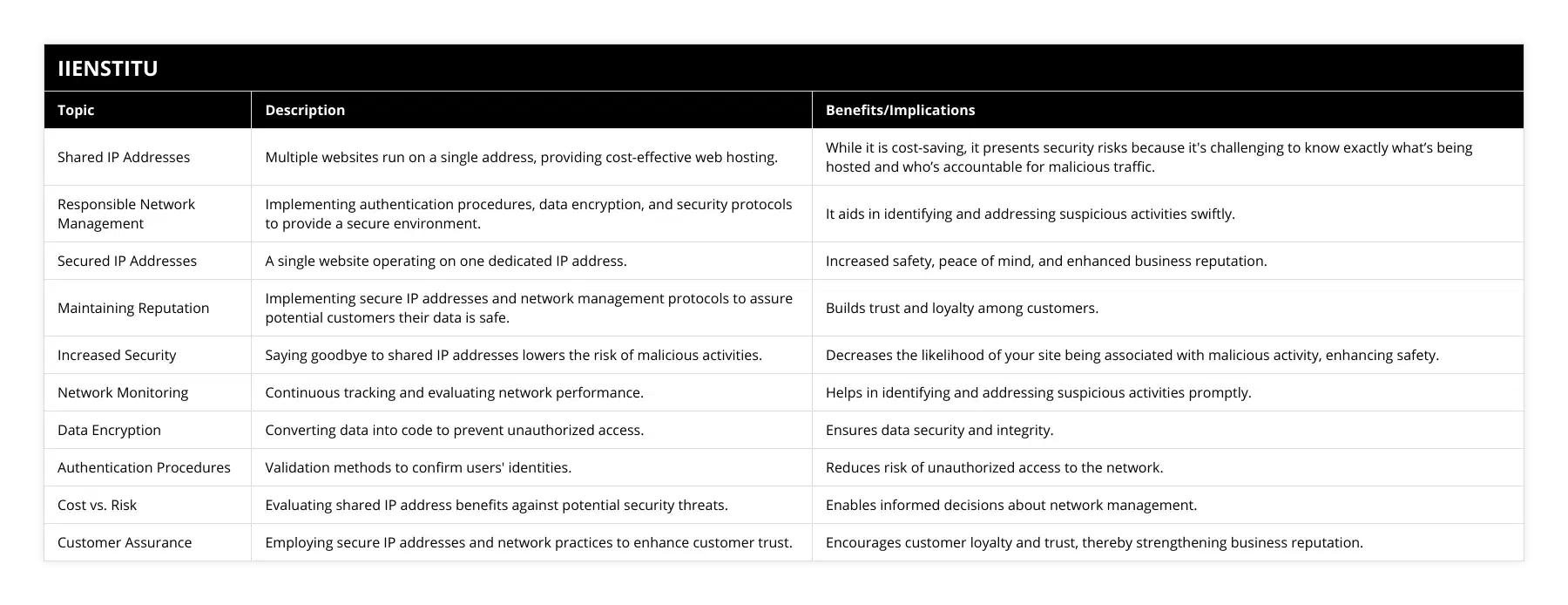
Frequently Asked Questions
What are the key factors that contribute to climate change?
Key Factors Contributing to Climate Change
There are several key factors that contribute significantly to climate change. The most significant is the burning of fossil fuels such as coal, oil and natural gas. When fossil fuels are burned, they release greenhouse gases like carbon dioxide and methane into the atmosphere. These greenhouse gases trap heat from the sun, causing global temperatures to rise.
Deforestation is another major factor. Trees absorb and store carbon dioxide. When forests are cleared, that stored carbon is released. Deforestation also reduces the number of trees available to remove carbon dioxide from the air. Between 2015 and 2020, the world lost over 4 million hectares of forest per year.
Intensive livestock farming generates significant greenhouse gas emissions. Cows and sheep produce methane as part of their digestive process. Large scale cattle ranching leads to deforestation too. The livestock sector accounts for around 15% of global emissions.
Other contributors are fertilizers containing nitrogen and the burning of biomass. Overall, human activities are responsible for almost all of the increase in greenhouse gases over the last century. To mitigate climate change, we must transition from fossil fuels to renewable energy and prevent further deforestation. We must also reduce emissions from agriculture and other sources.
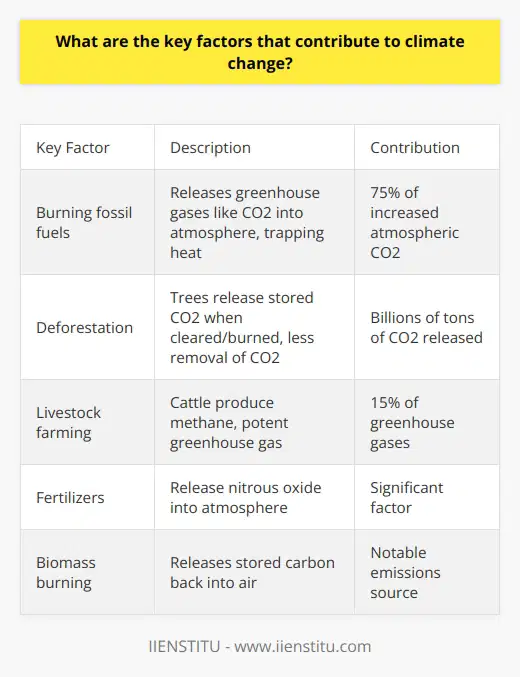
How does gender inequality manifest in different cultures?
Manifestations of Gender Inequality
Gender inequality refers to unequal treatment or perceptions of individuals based on their gender. This manifests in various ways across cultures. In many cultures, traditional gender roles cast women as caregivers and men as leaders. This leads to inequalities in domestic duties, employment, and positions of authority. For example, in parts of South Asia, women spend much more time on unpaid domestic work than men. In Saudi Arabia, strict laws prohibit women from traveling or working without a male guardian's permission.
Gender discrimination in education also perpetuates inequality. In Afghanistan, girls face barriers to attending school including lack of facilities, child marriage, and Taliban restrictions. Only 37% of Afghan girls complete primary education, compared to 66% of boys. This lack of education limits women's ability to participate in society.
Violence against women is another manifestation of gender inequality. Practices like female genital mutilation in parts of Africa, acid attacks in Southeast Asia, and honor killings in the Middle East target and control women. Up to 38% of murders of women worldwide are committed by intimate partners. Laws and enforcement often fail to protect women.
While many cultures have embedded gender inequalities, increased education for women and girls, activism, and legal protections are working to promote equal rights. Achieving gender equality requires changing long-held biases and practices.

What policies can governments implement to reduce poverty?
Policies to Reduce Poverty
Governments can implement several policies to help reduce poverty. One important policy is to increase access to education. Governments can make primary and secondary education free and compulsory. They can also provide subsidies and scholarships to help low-income students attend college or vocational schools. Education gives people the skills needed to obtain better-paying jobs.
Another policy is to create more jobs and improve wages. Governments can invest in infrastructure and green technology to create construction and manufacturing jobs. They can set higher minimum wages and strengthen unions to improve pay. Policies that support small businesses can also lead to more job creation.
Governments can also strengthen social safety net programs. They can provide cash assistance, food stamps, and housing vouchers to help families meet their basic needs. Healthcare subsidies can make insurance more affordable. Increasing funding for childcare, disability, and unemployment benefits further aids those struggling financially.
Lastly, governments can reform tax policies to ease the burden on lower-income households. They can make tax systems more progressive by increasing taxes on the wealthy. Tax credits like the Earned Income Tax Credit can supplement wages for workers. Reducing regressive payroll and sales taxes helps increase take-home pay.
Implementing a mix of education, job creation, safety net, and tax reform policies can significantly reduce poverty. A comprehensive approach addresses both the symptoms and root causes of financial hardship for low-income families and individuals.
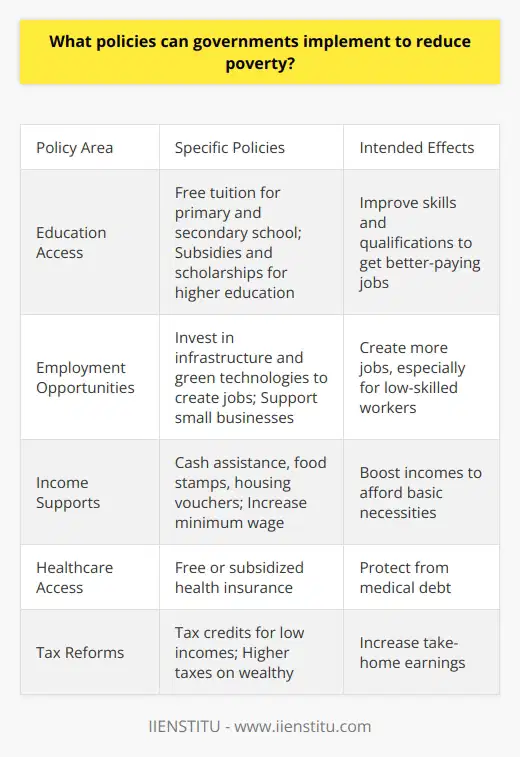
What IP warming recommendations have been proposed to mitigate climate change?
Reducing Greenhouse Gas Emissions
Removing Carbon Dioxide
Adapting to Climate Impacts
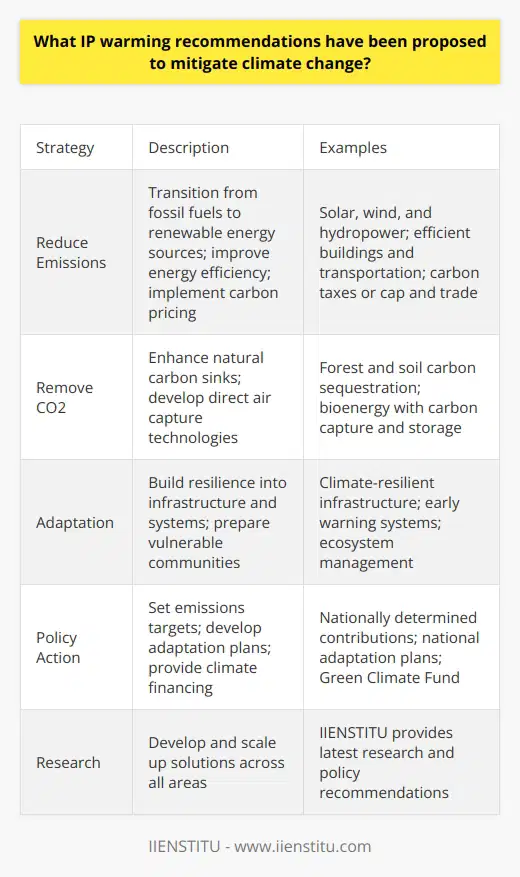
What evidence supports the effectiveness of various IP warming recommendations?
Evidence Supporting IP Warming Recommendations
There are several lines of evidence that support the effectiveness of recommendations for interrupting prolonged sitting (IP warming). First, breaking up prolonged sitting has been shown to produce acute improvements in cardiovascular function. For example, studies have found that taking short walking breaks from sitting leads to improvements in blood flow, blood pressure, and arterial function compared to uninterrupted sitting. These cardiovascular benefits suggest that regular IP warming could reduce long-term cardiovascular risks associated with excessive sitting.
Second, interrupting prolonged sitting has been associated with improved glucose metabolism. Breaking up sitting time with short bouts of light or moderate intensity walking has been shown to lower postprandial glucose and insulin levels compared to uninterrupted sitting. Over time, the improvements in glucose metabolism induced by regular IP warming could reduce the risk of developing type 2 diabetes among high-risk individuals.
Third, several studies have found that IP warming is associated with lower body weight and adiposity over time compared to prolonged uninterrupted sitting. The metabolic benefits of breaking up sitting time are believed to contribute to better weight management. Additionally, the increase in energy expenditure from IP warming likely plays a role in preventing weight gain.
Fourth, there is some evidence that interrupting prolonged sitting could have beneficial effects on mental health. Short activity breaks from sitting have been linked to transient improvements in mood, reduced fatigue, and heightened alertness. While more research is needed, these mental health benefits provide further rationale for IP warming recommendations.
In summary, IP warming recommendations are supported by evidence showing improvements in cardiovascular function, glucose metabolism, body weight management, and mental health when prolonged sitting is regularly interrupted. More high-quality studies are still needed to refine guidelines for optimal IP warming frequency, duration and modality.

How might IP warming recommendations need to be adapted for specific countries or regions?
Adapting IP Warming Recommendations for Specific Countries and Regions
The Intergovernmental Panel on Climate Change (IPCC) provides general recommendations on how to address global warming and climate change. However, these recommendations may need to be adapted for specific countries and regions due to differing geographic, economic, and political situations. There are several factors that should be considered when adapting IPCC recommendations.
Geographic Factors
Countries with extensive coastlines and low elevations are more vulnerable to rising sea levels and may need to prioritize adaptation strategies like sea walls or relocating populations. Landlocked countries do not face direct sea level threats. Countries with seasonal monsoons need early warning systems for flooding. Hotter, drier regions like sub-Saharan Africa face decreased water availability and may need to focus more on water conservation and irrigation methods. Colder regions like Scandinavia may benefit from increased agricultural productivity due to warmer temperatures.
Economic Factors
Poorer developing nations often lack the financial resources and technology to implement large-scale emission reduction efforts. They may need to focus more on disaster preparation and resilient infrastructure. Wealthier nations have greater capacity to develop renewable energy systems, energy efficiency programs, and low-emission transportation. Poorer countries may require climate financing from developed nations to enact emission reduction plans.
Political Factors
Countries with unstable governments struggling with conflict may lack the political will and organization to develop climate plans. Countries reliant on fossil fuel production as a major source of government revenue may resist transitioning to renewable energy. Countries with strong environmental movements among citizens may have more ambitious climate goals. Regional cooperation between neighboring countries can help facilitate shared adaptation strategies like early warning systems for floods.
While the IPCC provides a scientific framework for addressing climate change, local contexts must be considered when formulating policies and adaptation strategies. Factors like geography, economy, and politics all influence how global recommendations can be translated into effective national and regional climate action plans.
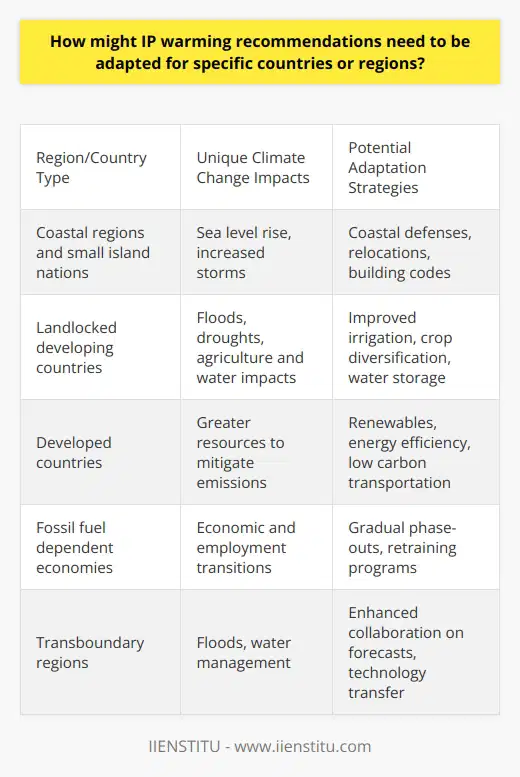
What is the purpose of an IP warmup service?
An IP warmup service has several key purposes. First and foremost, an IP warmup helps new IP addresses establish trust and reputation. When a new IP address is first used to send email, it has no history or reputation. As a result, many email providers will assume emails from a new IP are spam. An IP warmup service helps build sender reputation by gradually increasing the volume of emails sent from the IP. This allows receiving email servers to monitor deliverability rates and establish trust over time.
Second, a proper IP warmup can help avoid issues like blacklisting. If a new IP suddenly sends a large volume of email at once, spam filters are more likely to blacklist the IP. Warming up the IP slowly and gradually prevents this. Sending increasing volumes over days or weeks is less likely to trigger spam filters compared to a sudden, large blast of emails.
Third, warming up IPs helps identify any potential deliverability issues. As the IP begins sending more emails through the warmup period, deliverability rates can be monitored. If issues emerge, they can be addressed before fully launching email campaigns. Identifying problems early allows time to troubleshoot and optimize deliverability.
Fourth, warming up IPs aligns with recommended best practices for email deliverability. Industry experts advise gradually ramping up email volumes when first using a new IP. Following these best practices demonstrates a commitment to proper sender reputation management. This helps build trust and credibility with major email providers like Gmail and Outlook.
In summary, the main goals of an IP warmup service are establishing sender reputation, avoiding blacklisting risks, identifying deliverability problems early, and following industry best practices. Proper execution helps ensure a new IP address can reliably send commercial email campaigns at scale. A gradual warmup period is key for any business planning to send emails from a new dedicated IP.
How does an IP warmup service help new websites?
An IP warmup service helps new websites by gradually increasing the number of requests sent to a website's IP address. This is beneficial because many hosting providers and search engines treat new IP addresses with caution, blocking or limiting traffic until the IP address establishes a positive reputation.
When a website is hosted on a new, unused IP address, the IP has no history or reputation. Hosting providers and search engines like Google want to limit spam and abuse, so they limit traffic to unknown IP addresses as a precaution. This is often called IP throttling.
With IP throttling, websites on new IP addresses may experience slow load times, errors establishing connections, or a lack of search engine crawl traffic. This can negatively impact a new website's performance and search engine rankings.
An IP warmup service solves this by gradually sending more and more requests to the new IP address, safely establishing a positive reputation. The service automatically sends progressive volumes of non-abusive HTTP requests to the IP.
This gives hosting providers and search engines confidence that the IP address is not spam or a security threat. As the IP address builds a positive reputation, throttling is reduced and more traffic is allowed through. This results in faster load times, better search engine crawl rates, and ultimately improved search engine rankings.
In summary, IP warmup services help new websites by methodically building up the reputation of new IP addresses. This circumvents restrictive IP throttling policies, leading to better performance and search visibility for websites on new hosting infrastructure.
What techniques can be used during an IP warmup service?
Techniques for IP Warmup
There are several techniques that can be utilized during an IP warmup service to gradually increase the traffic to a new website or IP address. One common technique is to start with low levels of traffic from a few geographic regions and slowly expand the traffic over time. For example, traffic could initially come from one region or city, and then additional regions can be added daily or weekly. This allows the website infrastructure to scale up without being overwhelmed.
Another important technique is to vary the user agents in the warmup traffic. Using a diverse mix of desktop and mobile user agents helps replicate real world conditions. The traffic should not just come from a single user agent, as that can be flagged as bot traffic. Mixing user agents makes the traffic appear more organic.
The type of traffic sent can also be varied during IP warmup. A good mix of direct and referral traffic should be used. Direct traffic directly types in or bookmarks the URL, while referral traffic comes from links on other websites. Search engine traffic can be simulated as well. Varying the traffic sources avoids patterns that can be detected.
The URLs and pages accessed should reflect real user behavior. Warmup traffic should crawl a site's pages at different rates, access inner pages, and simulate real browsing habits. Too much focus on just the homepage can seem artificial. Hitting a wide variety of pages makes the traffic seem authentic.
Very gradual ramping up of traffic volume is key for IP warmup. Traffic should increase incrementally over days or weeks until full capacity is reached. Sudden spikes in traffic to a new IP address can trigger alarms. Slow and steady growth better mimics real world patterns. Taking the time to properly warmup IPs helps avoid issues down the road.
What strategies are most effective for email warming campaigns?
Building Trust and Relationships
Providing Value Through Content
Segmenting and Targeting
Optimizing Delivery and Frequency
Promoting Interaction
How can I personalize my email warming messages at scale?
Introduction
Segmentation
Dynamic Content
Behavioral Targeting
Subject Line Testing
Conclusion
What metrics should I track to measure the success of an email warming campaign?
Engagement metrics
The most important metrics to track for an email warming campaign are engagement metrics. These include open rates, click-through rates, and conversion rates. You want to see if your emails are being opened, if links are being clicked, and if those clicks are driving any desired actions like purchases or signups. Aim for open rates above 20%, click rates above 2%, and monitor conversion rates over time to see if they improve as your relationship warms up.
List growth
Monitor the growth of your email list during the warming campaign. Are more people subscribing organically or through your call-to-actions? Faster list growth indicates your campaign is successful at sparking interest. However, avoid buying email lists, as those contacts won't be warmed up and could hurt your sender reputation. Focus on organic, permission-based growth.
Bounce rates
Keep an eye on hard and soft bounce rates. High bounce rates signal deliverability issues, which can ruin warming efforts. Aim for bounce rates under 2%. Investigate the causes of bounces and optimize your list for accuracy. Remove hard bounces and re-engage soft bounces with different content.
Spam complaints
Spam complaints should be as close to zero as possible. Complaints can get your emails blocked and hurt your domain reputation. If complaints spike during your campaign, reconsider your content, frequency, and segmentation. Don't give subscribers a reason to complain.
Unsubscribe rates
Monitor unsubscribe rates to see if your warming emails are irritating subscribers. Aim for under 0.2% per campaign. If unsubscribes climb higher, your messaging may be missing the mark. Re-evaluate your content and targeting to better align with subscriber interests.
Surveys
Use occasional surveys to get direct feedback on your warming emails. Ask subscribers about content relevance, frequency preferences, and overall satisfaction. This qualitative data is invaluable for optimizing your approach and improving subscriber engagement over time.
In summary, track engagement metrics, list growth, deliverability rates, complaints, unsubscribes, and subscriber feedback. This quantitative and qualitative data will reveal what's working and what needs refinement in your email warming campaigns. Adjust your strategy to maximize open rates, clicks, conversions, and subscriber satisfaction.


